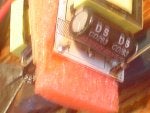The IMA and check engine lights came on on my 2001 insight about 200 miles ago. Since then, it hasn't had charge/assist and the state of charge indicator wasn't lit, two different Honda dealers pulled code P1449 from it. Both dealers gave me estimates to replace the battery for approximately $2300. The car still drove alright, but just not as powerful as it was with a working battery.
Over the last week or so I have been talking to Mountain Driver about grid charging my insight. I bought the discharge ready grid charger from Hybrid Automotive LLC. On 2/5, I went to Bob's house and he tested my battery fan and it worked, then he determined the IMA blink code to be 78 (battery module deterioration). So he thought that my car might benefit from grid charging. So we proceeded to remove the battery and take it inside his house because his garage isn't heated. Then we attached the wiring harness and hooked up the charger. We turned on the charger at 6:15pm and the battery's voltage was 149. Here is a chart of the rest of the charge:
Time Voltage
6:15 149
7:15 160
8:15 163
9:15 166
10:00 167
11:00 168
2:00 170
7:00 171
8:00 171
9:00 171
Then we put the battery back in the car and took it for a short test drive and the state of charge indicator quickly lit up to "full" and the charge/assist worked! I then drove 116 miles home and the car ran perfectly. The mileage home beat the car's lifetime mileage. Today I checked my tire's pressure and they were all low, so I added air and am now getting 54 mpg.
Here are some pictures of the removal of the battery, my dashboard, and of Bob's license plates:
https://www.flickr.com/photos/65849047@N00/sets/72157650681797532/
The metal bars that are attached to the battery were really helpful to lift/carry the battery.
I am so grateful to Bob (Mountain Driver).
Over the last week or so I have been talking to Mountain Driver about grid charging my insight. I bought the discharge ready grid charger from Hybrid Automotive LLC. On 2/5, I went to Bob's house and he tested my battery fan and it worked, then he determined the IMA blink code to be 78 (battery module deterioration). So he thought that my car might benefit from grid charging. So we proceeded to remove the battery and take it inside his house because his garage isn't heated. Then we attached the wiring harness and hooked up the charger. We turned on the charger at 6:15pm and the battery's voltage was 149. Here is a chart of the rest of the charge:
Time Voltage
6:15 149
7:15 160
8:15 163
9:15 166
10:00 167
11:00 168
2:00 170
7:00 171
8:00 171
9:00 171
Then we put the battery back in the car and took it for a short test drive and the state of charge indicator quickly lit up to "full" and the charge/assist worked! I then drove 116 miles home and the car ran perfectly. The mileage home beat the car's lifetime mileage. Today I checked my tire's pressure and they were all low, so I added air and am now getting 54 mpg.
Here are some pictures of the removal of the battery, my dashboard, and of Bob's license plates:
https://www.flickr.com/photos/65849047@N00/sets/72157650681797532/
The metal bars that are attached to the battery were really helpful to lift/carry the battery.
I am so grateful to Bob (Mountain Driver).










